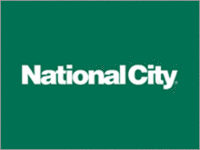美國國民城市銀行
出自 MBA智库百科(https://wiki.mbalib.com/)
目錄[隱藏] |
美國國民城市銀行 (紐約證券交易所: NCC ) ,總部設在美國俄亥俄州克裡夫蘭市 ,並於1845年成立,曾經是十年最大的銀行在美國的存款,抵押貸款和房屋凈值信用額度貸款。
國民城市銀行是美國第十大銀行,也是俄亥俄州第一大銀行。
- Industry:Super Regional Banks
- Products:commercial and retail banking, mortgage financing and servicing, consumer finance and asset management
- Revenue:$12.952.7b (17.4%) FY2006
- Net income:$2.3b (15.9%) FY2006
- Employees:31,270 (2006) Full-Time
National City Corporation (NYSE: NCC), based in Cleveland, Ohio, USA, and founded in 1845, used to be one of the ten largest banks in America in terms of deposits, mortgages and home equity lines of credit. Subsidiary National City Mortgage is credited for doing the first mortgage in America. The company operates through an extensive banking network primarily in Ohio, Illinois, Indiana, Kentucky, Michigan, Missouri, Pennsylvania, Florida, and Wisconsin, and also serves customers in selected markets nationally. Its core businesses include commercial and retail banking, mortgage financing and servicing, consumer finance, and asset management. The bank reaches out to customers primarily through mass advertising and offers comprehensive banking services online.
截至2007年,National City Corp.在《財富》500強榜單上排名第188位,在美國商業銀行業收入排名第9位,總資產約1400億美元,市值245.42億美元。
The Wall Street Journal reported on June 6, 2008 that National City Corp. had entered into a memorandum of understanding with federal regulators, effectively putting the bank on probation. Terms of the confidential agreement, entered into a month earlier with the Office of the Comptroller of the Currency (which regulates nationally chartered banks), were not known.[1]
On June 10, 2008, National City Corp. confirmed that it had reached agreements with regulators "regarding capital levels, risk-management practices and other aspects of its business." The company stated that there had been no material developments in these areas since these memorandums of understanding were signed in April and May, 2008.[2]
National City Bank was founded on 17 May 1845, when a group of Cleveland businessmen pooled $50,000 to organize the City Bank of Cleveland, the first bank opened under the Ohio Bank Act of 1845 in a small town with no gas, electricity, public waterworks, or railroad. [3] Reuben Sheldon and Theodoric C. Severance, formerly of the Fireman's Insurance Company, organized The City Bank of Cleveland. The city's only bank at the time, opened its doors to the public at No. 52 Superior Street. [4]
Historical timeline
- 1845: Reuben Sheldon and Theodoric C. Severance, formerly of the Fireman's Insurance Company, organize The City Bank of Cleveland.
- 1865: City Bank of Cleveland becomes National City Bank of Cleveland, receiving a national charter that includes the right to print federal money. This responsibility lasts until the 20th century, when the Federal Reserve assumes the function of printing all U.S. currency.
- 1881: National City Bank records more than $1 million in assets.
- 1901: National City Bank passes $2 million in assets.
- 1912-1913: National City Bank's assets rise from $2.5 million to $4.5 million.
- 1914-1918: National City Bank purchases $100 million in U.S. Bonds to help finance World War I and sees its own assets increase to $15.5 million.
- 1929: National City Bank accumulates $40 million in assets.
- 1933: National City Bank is the only bank in Cleveland giving 100 cents on the dollar to its depositors, while for several weeks most other banks are providing only five cents on the dollar.[citation needed] When many other banks are forced to shut down permanently following FDR's banking moratorium, National City Bank is deemed to be solid, and is permitted to resume full operations.
- 1945: Nearing $500 million in assets, National City Bank celebrates its 100th Anniversary.
- 1972: National City Bank's assets pass $2 billion.
- 1973: A new holding company, National City Corporation, is created with National City Bank (its name shortened from National City Bank of Cleveland) as its lead bank and primary subsidiary.
- 1975: National City Bank purchases the assets of the failing Northern Ohio Bank for $3.7 million.
- 1976: National City Bank spends $3.8 million acquiring The Bank of Cleveland.
- 1977: The First National Bank of Dayton is the corporation's first major acquisition. Two banks had merged to create the Dayton Bank in 1961: Merchant's National Bank (1871) and People's Bank & Trust Co. (1957).
- 1978: The Huron County Banking company in Norwalk, Ohio, is acquired. The bank is renamed National City Bank, Norwalk in 1985.
- 1980: National City Bank moves its headquarters to the newly constructed 35-story National City Center, as does its parent company, National City Corporation.
- 1982: Ohio Citizens Bancorp in Toledo is acquired.
- 1982: The Goodyear Bank in Akron is acquired. Founded in 1933 by the Goodyear Tire & Rubber Company, it was Ohio's first company-owned bank.
- 1982: Beginning in May, National City Bank becomes one of two Cleveland banks to link its Visa and MasterCard credit card interest rates to the cost of money, changing interest fees every six months according to the fluctuations of Treasury Bill Rates.
- 1982: National City Bank reports a resumption of growth in annual earnings.
- 1984: National City Corporation acquires BancOhio Corporation of Columbus to create the state's largest bank holding company. Together their assets total $12.5 billion, with a banking network encompassing 350 branches in 52 of the state's 88 counties.
- 1986: National City Bank acquires 14 area offices and $460 million in deposits of the Broadview Savings and Loan Company.
- 1988: National City Corporation expands into the Kentucky market by acquiring First Kentucky National Corporation of Louisville. Member banks of First Kentucky include First National bank of Louisville (1863); American National Bank & Trust Company, Bowling Green (1886); Crestwood State Bank (1896); Central Bank and Trust Company, Owensboro (1890); third National Bank of Ashland (1916); and First National Bank of Indiana, New Albany (1904). The largest, Commerce National in Lexington, resulted from a merger of Bank of Commerce (1911) and Second National Bank (1883).
- 1989: National City Mortgage Company acquires Shawmut Mortgage Company in Miamisburg, Ohio.
- 1990: National City corporation establishes National City Investment Corporation, allowing the corporation to offer investment choices equal to that of a full-service brokerage.
- 1990: Gem Savings Association, a $1.6 billion asset savings and loan company with 25 branches in Dayton and Cincinnati, is acquired.
- 1991: In October, National City Corporation announces it has reached an agreement with Merchants National Corporation to acquire the Indianapolis-based holding company. Member banks of Merchants National consist of: Anderson Banking Company (1890); Batesville State Bank (1889); Central National Bank of Greencastle (1883); Citizens National Bank of Tipton (1904); Elston Bank & Trust Company (1853); Farmers National Bank of Shelbyville (1886); Fayette Bank and Trust Company (1902); First National Bank of East Chicago (1909); First National Bank of Indiana, Logansport (1931); Hancock Bank & Trust Company, Greenfield (1874); Madison Bank & Trust Company (1833); Mid State Bank, Zionsville (1882); Mid State Bank of Hendricks County, Danville (1904); The National Bank of Greenwood (1934); The Seymour National Bank (1891); and Union State Bank, Carmel (1923).
- 1993: National City acquires Ohio Bancorp, Youngstown. Its member banks are: The Dollar Savings and Trust Company, Youngstown (1887); The Potters Bank and Trust Company, East Liverpool (1881); Peoples Banking Company, Martins Ferry (1891); Bank 2000, Minerva (1915); and The Miners and Mechanics Savings and Trust Company, Steubenville (1913).
- 1995: Central Indiana Bancorp, Kokomo and United Bancorp of Lexington, Kentucky are acquired.
- 1995: National City celebrates its 150th Anniversary with $32 billion in assets, 640 branches and 20,000 employees.
- 1997: National City merges with First of America creating the 13th largest banking organization in the U.S. at that time in terms of total assets. First of America is a $22 billion asset bank holding company headquartered in Kalamazoo, Michigan. The combined company had assets of $74.4 billion, deposits of $48.4 billion and stockholders' equity of $6.1 billion.
- 1997: National City purchases certain assets of the mortgage loan origination businesses owned by First National Mortgage Corporation and Eastern Mortgage Services, Inc, and American Mortgage Source, Inc.
- 1998: National City acquires Fort Wayne National Corporation with assets of $3.3 billion.
- 1999: National City closes on acquisition of First Franklin Financial Companies.
- 2004: National City completes $2.1 billion purchase of Cincinnati-based Provident Financial Group.
- 2004: National City acquired Wayne Bancorp, a bank holding company headquartered in Wooster, Ohio which operated 26 branches and had $825 million in assets.
- 2005: National City acquired Allegiant Bancorp to enter the St. Louis market, adding 36 branch locations to National City's network of 1,100 retail offices located throughout the midwest.
- 2006: National City sells First Franklin group to Merrill Lynch & Co. $1.3 billion.
- 2006: National City acquires Fidelity Bankshares. Headquartered in West Palm Beach, Fidelity had $4.2 billion in total assets and operated 52 branches. *2006: National City acquires Harbor Florida Bancshares, the holding company for Harbor Federal Savings Bank. Harbor Florida is the fifth-largest publicly traded banking institution based in Florida. Headquartered in Fort Pierce, Harbor Florida has total assets of $3.2 billion and 40 branches.
- 2007: National City acquires MAF Bancorp, Inc., the holding company for MidAmerica Bank, which operates 82 branches throughout Chicago and Milwaukee and surrounding areas. MidAmerica is the 11th largest banking institution in the Chicago market with $5.7 billion in deposits and 58 branches and the fifth largest in Milwaukee with $1.3 billion in deposits and 24 branches.
- 2007: Peter Raskind succeeds David A. Daberko as President and CEO of the company, after Daberko was criticized for his disasterous expansion into subprime mortgages, ill-timed bank acquisitions and share buy backs, and most embarrassing, his penchant for wasting shareholder money on corporate jets and greens fees.
- 2007: National City announces that their Wholesale Mortgage Division will cease operations effective December 31, 2007 in the face of record foreclosures. Employees were notified via email and conference call from Buck Bibb, head of National City Mortgage.
- 2008: National City Corp. disclosed in a regulatory filing that it is the subject of an "informal" Securities and Exchange Commission investigation related to matters including loan underwriting, bank regulatory matters, and the sale of a subprime subsidiary, First Franklin Financial Corporation, to Merrill Lynch & Co. for $1.3 Billion in 2006.
National City has been on an acquisition spree of late, including its $2.1 billion purchase of Cincinnati-based Provident Financial Group in 2004. In addition, in 2005, National City acquired Allegiant Bancorp to secure a presence in the St. Louis, MO market. In 2006, they acquired Fidelity Bankshares Inc. for an estimated $1 billion dollar deal that is half cash, half stock. Also acquiring Harbor Florida Bancshares Inc. through a $1.1 billion stock deal, both banks are located in Florida. Combined it gives National City $7.4 billion of assets in Florida. It also gives National City 94 branches in a market that is growing quickly. On the other side of the ledger, National City sold to Bank of America its 83% stake in National Processing Company, which earns fees from processing merchant credit card transactions. The sale of San Jose, California based First Franklin origination franchise and related servicing platform to Merrill Lynch & Co. was completed on 30 December 2006 for $1.3 billion. In May 2007, National City announced the purchase of MAF Bancorp Inc., the holding company for MidAmerica Bank. As of 30 June 2006, MidAmerica Bank had the 9th-ranked market share in the Chicago-Naperville-Joliet Metropolitan Statistical Area at 2.18%. Following the merger using the same dataset, the combined National City and MidAmerica Banks will rank 4th in the market with a market share of 3.96% and deposits of more than $10 billion.[5]
Now there is speculation in the Wall Street Journal that National City Bank with help from Goldman Sachs are shopping the bank for purchase. The rough housing market has led to NCB into dark waters filled with many failing mortgages. This paired with poor economies in the core areas of National City Bank's retail location have severely hurt the company. Stocks have dropped from a 52 week high of over $38.00 per share down to just over $12.00 at the close of the day Friday once the news had hit the market that NCB may be sold. As of July 15th, the stock was trading at roughly $3 per share. According to Reuters, London banking giant HSBC has been identified as a potential buyer. As of October 2008, the stock price has been volatile going from $5 to $1.36 to $3 again. There seems to be major speculation about the company's well-being, as they have been known to be involved in the subprime market, but has yet to release any unexpectedly major negative results.
On April 20, 2008, Corsair Partners bought a stake in National City Bank. National City Bank will remain a Cleveland based bank with many employees not being laid-off. Corsair now effectively controls National City but agreed to let Peter Raskind keep his job. Raskind received criticism from shareholders for self dealing. It is believed that National City shareholders would have been better off had Raskind sold National City to Fifth Third. Recent accounting rule changes which require bad loans to be marked to market upon acquisition, made an acquisition of National City unattractive to Fifth Third and other strategic buyers.
- ↑ National City under U.S. regulatory scrutiny: report, Rueters, June 6, 2008
- ↑ National City confirms agreements with regulators, MarketWatch.com, June 10, 2008
- ↑ National City 150th Celebration Book Team: National City -- 150 Years, 1995
- ↑ http://www.answers.com/topic/national-city-corp National City Corp.: Information from Answers.com
- ↑ http://www2.fdic.gov/sod/sodMarketBank.asp?barItem=2 FDIC, Deposit Market Share – Pro Forma HHI Report Selection

 无广告阅读
无广告阅读  免验证复制
免验证复制  微信支付
微信支付  支付宝
支付宝  PayPal
PayPal 














